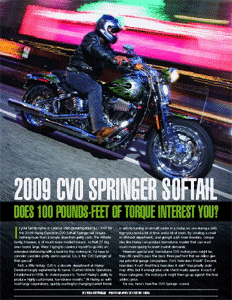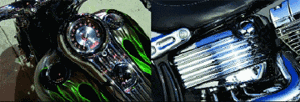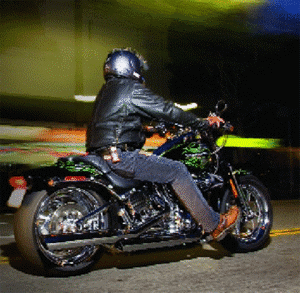If your family name is Croesus then plunking down $27,000 for the 2009 Harley-Davidson CVO Softail Springer will require nothing more than a simple draw from petty cash. The Kittrelle family, however, is of much more modest means, so that 27 big ones looms large. Were I trying to convince myself to go into an extended relationship with a bank for this motorcycle, I’d have to consider said bike pretty damn special. So, is the CVO Springer all that special?
First, a little history. CVO is a discrete department at Harley-Davidson largely explained by its name: Custom Vehicle Operations. Established in 1998, its stated purpose is “to test Harley’s ability to produce highly customized, low-volume models.” At Harley, as with most large corporations, quickly reacting to changing market trends is akin to turning an aircraft carrier in a molasses sea during a Jello fog—you need a lot of time and a lot of room. By creating a smaller offshoot department, and giving it a bit more freedom, companies like Harley can produce low-volume models that can react much more quickly to meet market demands.
However special and low-volume CVO motorcycles might be, they still need to pass the basic three-part test that we riders give our potential garage companions. First, how does it look? Second, how does it run? And third, how does it ride? Your priority order may differ, but if enough plus-side check marks appear in each of those categories, the motorcycle might then go up against the final arbiter: price.

For me, here’s how the CVO Springer scored.
How does it look?
You made your decision as soon as you saw the picture, so I won’t dwell on this very subjective category. My only caveat might be that it looks even better in person, under the summer sun. To me, it is a beautiful piece of metal art. And remember, I’m the guy who likes basic black, and is a bit cavalier about washing motorcycles.
CVO motorcycles are traffic-stoppers with the responses running the gamut from gushing (almost always) to the occasional gagging. Personally, I think some of the past models have been a bit overdone, but not in this instance. With its Black Diamond and Emerald Ice Flames finish, this motorcycle drew appreciative stares like few I’ve ever ridden.
Chrome is the coin of the realm with CVO models. It’s lavished on each of 2009’s four CVOs, but mostly so with this Springer. From its chromed Softail swingarm to its signature Springer front end you’re never more than a couple of inches from the bright stuff. Particularly eye-catching is the cast aluminum horseshoe oil tank that resides just under the seat; it’s pretty enough for your trophy shelf.
How does it run?
CVO bikes hold the exclusive on the biggest motors in the family and since 2007 that means 110 cubic inches. Their horsepower ratings are relatively low, but that is a misleading number. While Joe “DynoMan” Minton saw only a modest 75 horses at 4,600 rpm, the number that grabbed his attention, and my butt, was 101 pounds-feet of delicious torque at a piddling 3,100 rpm. Hell, it puts out over 80 pounds-feet of torque at idle! What this means is that maximum grunt happens right now, and stays with you through the gears and just about at any speed you choose. Also, take note that these are rear-wheel, where-the-rubber-meets-the-road numbers. Very impressive.

Dyno-speak can be fun while sitting around the campfire, but out on the road is where the real giggles happen. The Twin Cam 110B motor makes quick work of passing anything you’d like to pass, regardless of the grade. Plus, there’s no need to downshift from one of its six speeds; just twist the grip and you’re at point B before you’ve had a decent chance to say goodbye to point A. Speaking of gears, sixth is largely useless until you’re over about 75 mph. Were you traveling across the plains states in a hurry, it would be useful. Other than that it just fills an empty spot in the gearbox and gives marketing something to yammer about.
The B in TC110B indicates that this motor is rigidly mounted to the frame and has an internal balancing shaft, rather than being rubber-mounted as with the non-Softail models. This gives the motorcycle a different feel; not better, not worse, just different. Well, maybe a little better. I’ve always felt that the shifting action with these balanced motors is crisper, more precise than that of the rubber-mounted versions. Vibration is never an intrusive or annoying factor. Bottom line? This is a great motor that will continually amuse you with its power.
How does it ride?
The Softail suspension design just can’t handle rough or uneven surfaces with any degree of finesse. On smooth surfaces it’s fine, even comfortable. Just stay off the frost heaves and avoid the potholes. Contributing to this rough ride is the 240mm rear tire. You might think that this fat weenie would have a cushioning effect. Nope. With an aspect ratio of 55, the actual sidewall height—that’s where the cushioning comes in—is quite low, giving up ride comfort on less-than-perfect roads. As with the Softail design, these fat tires were made for looks, not function.

The revelation with this motorcycle is that Harley has the big-tire thing figured out from a handling standpoint. Usually, almost always, the very large tires on the back of cruisers do more to hurt the handling of a motorcycle than anything else. Talk with suspension engineers and they’ll often tell you that they wished the fat-tire fad would just disappear. The most noticeable issue, aside from the aforementioned hard ride, is that they tend to steer the bike from the rear. Turning effort can be high and, in general, the bike fights back, preferring to stand up in turns rather than lean in. Not with this CVO Springer; the handling was quite good for this type of motorcycle. Contributing to this, certainly, is the 130mm 18-inch front tire, as it is closer in size to the rear rubber than the usual skinny front hoops found on custom cruisers.
Great looks, maximum grunt, and decent handling add up to being a motorcycle worth owning. But it’s not a great one, with one major issue and a couple of smaller ones keeping it from reaching that level. The big issue is the front brake. Initial bite is good, but hard braking requires far too much lever effort. There is no excuse for this. The Harley-Davidson FLs (including both CVO FLs) are fitted with excellent Brembo calipers. These should also be on the CVO Springer. The second issue is one of those small things that—once again—makes me wonder if various engineers at Harley ever talk with each other. Take a look at the picture of the rear brake lever and its position relative to the footpeg. To operate the brake you need pivot your foot in at an awkward angle, or rest it on the peg pivot, off of the pad. Terrible ergonomics.
The last item on my short list of negatives is controversial, and you may not agree. On several Harley-Davidson models of late, chrome plating of the muffler has been replaced by chromed covers. A casual glance can’t tell the difference. Look closer, though, and you’ll see the covers are held on by worm clamps. This is done to provide additional cooling for the integral catalytic converter. The mufflers themselves are chromed, but quickly “blue” from the heat, thus the necessity for an additional chromed cover offering a cooling airspace.
One thing I thought I knew about the CVO Springer was that it was not a touring bike; profilin’ and stylin’ is its game. I was wrong. All it needs is a windshield and saddlebags. My first 400-mile trip was miserable as I bucked a cold headwind the whole distance. Learning from that, I ordered up Harley’s detachable windshield, and it changed my opinion. Protection from the wind allowed me to really enjoy that 110 cubic inches of motor for my next 900 miles of use. It definitely takes away some style points but then, that’s why it’s detachable.
Evaluating a motorcycle in this price range brings a more critical approach to bear. The CVO Springer is powerful, looks great, handles better than you think it would, and satisfies all sorts of hidden needs and desires (you’ll have to ride it to know what these are). As mentioned, the brakes need upgrading, plus various bits and pieces of hardware showed oxidation. And then there’s the low-volume issue. Harley scheduled 2,500 CVO Softail Springers to be built for 2009. That’s a relatively small run for Harley, but it’s still a lot of motorcycles.
So, is the CVO Softail Springer special enough to warrant its $27,000 price? Ultimately, that’s for you and your banker to decide…unless, of course, you’re Croesus.








Still love my 2009 cvo screaming eagle Springer. Lot’s good rides. Bought in Jamestown when on holidays in usa . Alan Karen .still friend’s with Phil Eddy.
I remain a happy 09 FXSTSSE3 owner. It’s crude, rude, and an amazing bar hopper. One thing I would love to see documented is the story behind it’s creation, and some insight into the engineer(s) thoughts when they were designing it.